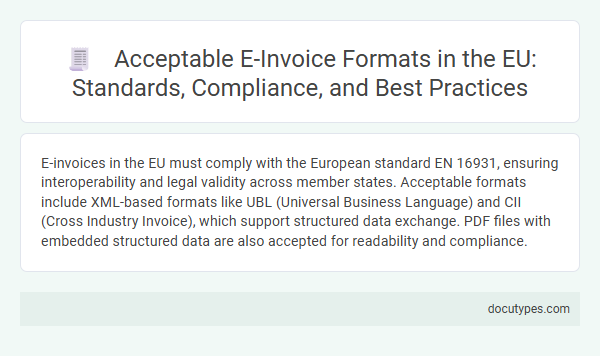E-invoices in the EU must comply with the European standard EN 16931, ensuring interoperability and legal validity across member states. Acceptable formats include XML-based formats like UBL (Universal Business Language) and CII (Cross Industry Invoice), which support structured data exchange. PDF files with embedded structured data are also accepted for readability and compliance.
Introduction to E-Invoicing in the EU
E-invoicing in the EU is a digital process that replaces traditional paper invoices with electronic documents. It enhances efficiency, compliance, and cross-border trade within the single market.
- UBL (Universal Business Language) - A widely accepted XML-based format designed for seamless electronic data interchange.
- EN 16931 - The European standard ensuring semantic interoperability across member states for e-invoices.
- PEPPOL - A network infrastructure supporting a standardized e-invoicing format that facilitates public and private sector transactions.
Your business can benefit from adopting these formats to meet legal requirements and improve transaction accuracy.
Key EU Regulations Governing E-Invoice Formats
What are the acceptable formats for e-invoices in the EU? The European Union mandates specific e-invoice formats to ensure interoperability and compliance across member states. Key regulations include the European Standard EN 16931, which defines the semantic data model for e-invoicing, promoting standardized electronic format usage.
Overview of Acceptable E-Invoice Formats
Electronic invoices (e-invoices) in the European Union must comply with specific formats to ensure interoperability across member states. These formats enable seamless processing and validation within diverse national systems.
The main acceptable e-invoice formats include XML-based standards such as PEPPOL BIS, UBL, and Factur-X. PEPPOL BIS is widely adopted for public procurement, ensuring a harmonized approach across the EU. Factur-X combines a PDF invoice with embedded XML data, supporting both human-readable and machine-readable elements.
The Role of EN 16931 European Standard
The European Union mandates specific formats for e-invoices to ensure interoperability and compliance across member states. The EN 16931 European Standard defines the semantic data model for e-invoices, providing a unified structure for electronic invoicing.
This standard supports multiple syntaxes such as XML and UBL, enabling consistent data exchange between businesses and public administrations. You must ensure that your e-invoices comply with EN 16931 to guarantee acceptance within the EU's public procurement systems.
XML vs. PDF: Format Comparison and Compliance
E-invoicing in the EU requires adherence to specific format standards ensuring compliance with legal and fiscal requirements. XML and PDF are the primary formats used, each offering distinct advantages for processing and validation.
- XML is the mandatory format for digital invoices under the EU Directive 2014/55/EU - It enables automated processing and seamless data exchange between systems across member states.
- PDF invoices are widely used for human readability and archival purposes - However, standard PDFs lack machine-readable data, which may limit compliance in certain contexts.
- Hybrid PDF/A-3 with embedded XML combines compliance and usability - This format supports legal archiving while including structured invoice data necessary for electronic workflows.
Peppol Network and Interoperability Standards
In the EU, acceptable formats for e-invoices include XML-based standards such as UBL (Universal Business Language) and CII (Cross Industry Invoice), which ensure compatibility across member states. The Peppol Network plays a crucial role by providing a standardized framework for exchanging electronic invoices securely and efficiently between businesses and public administrations. Your e-invoices must comply with these interoperability standards to facilitate seamless cross-border transactions and legal acceptance within the European Single Market.
Common Mistakes in E-Invoice Formatting
E-invoices in the EU typically adhere to formats like PEPPOL BIS, UBL, and Factur-X to ensure interoperability across member states. Common mistakes include incorrect data fields, missing mandatory information, and incompatible file formats that lead to processing delays. Ensuring your e-invoice matches the accepted XML or PDF/A-3 standards helps avoid rejection and facilitates smooth transactions.
Best Practices for E-Invoice Adoption
Understanding the acceptable formats for e-invoices in the EU is essential for seamless financial operations. Implementing best practices ensures compliance and efficiency in your invoicing process.
- PEPPOL BIS Billing 3.0 - A widely supported standard enabling cross-border e-invoicing across EU countries.
- UBL (Universal Business Language) - An XML-based format recognized for its interoperability and detailed invoice data representation.
- EN 16931 Compliance - Adhering to this EU directive guarantees standardized invoice content, facilitating automated processing and legal acceptance.
Ensuring Security and Data Protection
Acceptable formats for e-invoices in the EU include XML, UBL, and PDF/A-3, designed to meet interoperability and regulatory requirements. These formats ensure that invoice data is structured, machine-readable, and compliant with the European standard EN 16931.
Security measures such as advanced encryption and digital signatures are integral to these e-invoice formats, safeguarding data integrity and authenticity. Data protection compliance under GDPR mandates secure handling, storage, and transmission of invoice information throughout the invoicing process.
What Are the Acceptable Formats for E-Invoices in the EU? Infographic

